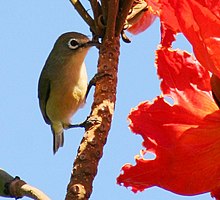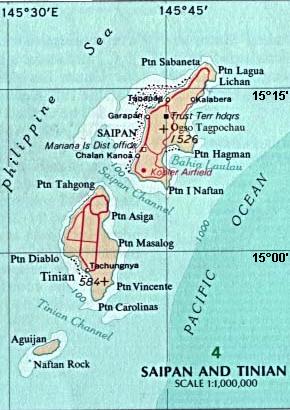
Tinian is one of the three principal islands of the Commonwealth of the Northern Mariana Islands (CNMI). Together with uninhabited neighboring Aguiguan, it forms Tinian Municipality, one of the four constituent municipalities of the Northern Marianas. Tinian's largest village is San Jose. Tinian is just south of the most inhabited island Saipan, but north of the populated Rota to the south. The island is home to many WW2 historical sites, cattle ranches, and beaches. There was a 5-star casino that operated from 1998 to 2015; remaining are other hotels/resorts and a golf course. The main access to Saipan is by a short airplane ride from the international airport, or by a charter boat.
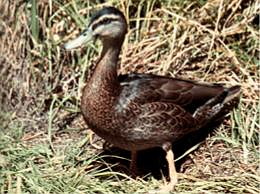
The Mariana mallard or Oustalet's duck is an extinct species of duck of the genus Anas that was endemic to the Mariana Islands. Its taxonomic status is debated, and it has variously been treated as a full species, a subspecies of the mallard or of the Pacific black duck, or sometimes as a subspecies of the Indian spot-billed duck.

The Guam rail, known in Chamorro as ko'ko', is a small, terrestrial bird in the Rallidae family. It is endemic of the island of Guam, and is one of the island's few remaining endemic bird species. The species became extinct in the wild in the early 1980s when biologists captured the remaining wild population. They have since been successfully reintroduced to Guam and introduced to the nearby Rota and Cocos islands. In 2019, the species became the second bird after the California condor to be reclassified by the IUCN from extinct in the wild to critically endangered.

The brown tree snake, also known as the brown catsnake, is an arboreal rear-fanged colubrid snake native to eastern and northern coastal Australia, eastern Indonesia, Papua New Guinea, and many islands in northwestern Melanesia. The snake is slender, in order to facilitate climbing, and can reach up to 2 meters in length. Its coloration may also vary, some being brown, green, or even red. Brown tree snakes prey on many things, ranging from invertebrates to birds, and even some smaller mammals. It is one of the very few colubrids found in Australia, where elapids are more common. Due to an accidental introduction after the events of World War II, this snake is now infamous for being an invasive species responsible for extirpating the majority of the native bird population in Guam. Currently, efforts are being made to reduce and control the population on Guam and prevent the snake from spreading to other locations.

The Guam flying fox, also known as the little Marianas fruit bat, was a small megabat endemic to Guam in the Marianas Islands in Micronesia that was confirmed extinct due to hunting or habitat changes. It was first recorded in 1931 and was observed roosting with the larger and much more common Mariana fruit bat. The last specimen was a female found roosting at Tarague cliff in March 1967, but it escaped capture. An unconfirmed sighting took place sometime during the 1970s, and no other individuals have been sighted since then.

The Mariana fruit bat, also known as the Mariana flying fox, and the fanihi in Chamorro, is a megabat found only in the Mariana Islands and Ulithi. Habitat loss has driven it to endangered status, and it is listed as threatened by the US Fish and Wildlife Service. Poaching, habitat loss, and the introduction of invasive species have contributed to the species' decline.

The Mariana fruit dove or Marianas fruit dove, totot on Guam or Paluman totut in Northern Marianas Islands, also known as mwee’mwe in the Carolinian language, is a small, up to 24 cm (9.4 in) long, green fruit dove native and endemic to Guam and the Northern Marianas Islands in the Pacific. It has a red forehead; greyish head, back and breast; and yellow belly patch and undertail coverts.
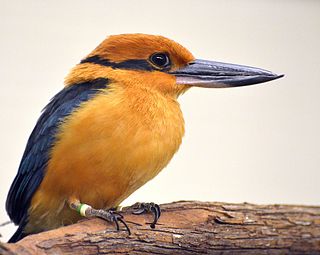
The Guam kingfisher is a species of kingfisher from the United States Territory of Guam. It is restricted to a captive breeding program following its extinction in the wild due primarily to predation by the introduced brown tree snake.
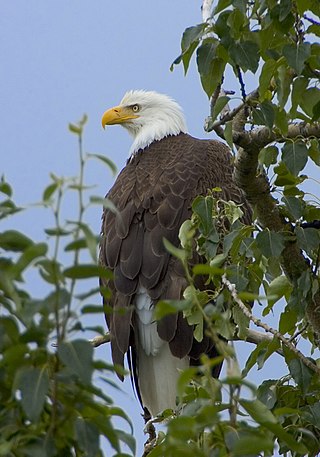
The fauna of the United States of America is all the animals living in the Continental United States and its surrounding seas and islands, the Hawaiian Archipelago, Alaska in the Arctic, and several island-territories in the Pacific and in the Caribbean. The U.S. has many endemic species found nowhere else on Earth. With most of the North American continent, the U.S. lies in the Nearctic, Neotropic, and Oceanic faunistic realms, and shares a great deal of its flora and fauna with the rest of the American supercontinent.

The nightingale reed warbler, or Guam reed-warbler, is an extinct songbird that was endemic to Guam.
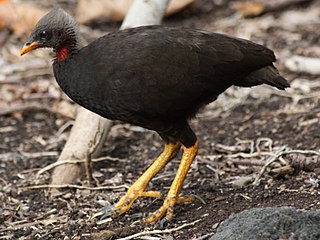
The Micronesian megapode or Micronesian scrubfowl is an endangered megapode which inhabits islands of the Western Pacific Ocean.
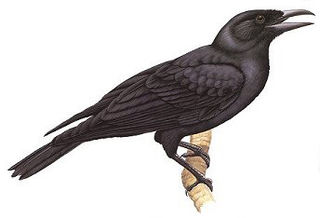
The Mariana crow is a species of the crow family from the tropical Western Pacific. It is a glossy black bird about 15 inches (38 cm) long and known only from the islands of Guam and Rota.
The Mariana swiftlet or Guam swiftlet is a species of swiftlet in the family Apodidae.
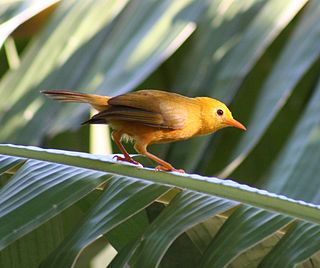
The golden white-eye is a species of bird in the white-eye family, Zosteropidae. It is the only species within the genus Cleptornis. The golden white-eye was once considered to be a honeyeater in the family Meliphagidae and although it is now known to be a white-eye, its position within that family is still uncertain. The species is restricted to the islands of Saipan and Aguijan in the Northern Mariana Islands, where it is sympatric and competes with the related bridled white-eye. The golden white-eye has golden plumage and a pale eye-ring. It feeds on insects, fruit, and nectar and forages in pairs or small family groups. The bird is monogamous and lays two eggs in a small cup nest.

The Tinian monarch is a species of bird in the family Monarchidae. It is endemic to the Northern Mariana Islands.

The Micronesian myzomela is a species of bird in the honeyeater family Meliphagidae. The species forms a superspecies with a number of related and similar looking island and mainland myzomelas across the Pacific and Australasia. It in turn is composed of seven insular subspecies.

The Rota white-eye or Rota bridled white-eye is a species of bird in the family Zosteropidae. It is critically endangered and endemic to Rota in the Northern Mariana Islands, where it mainly occurs in mature, wet limestone forests.

The Togian white-eye is a species of bird in the family Zosteropidae.
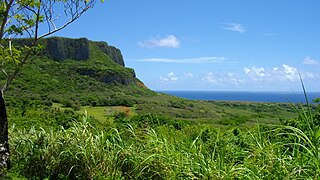
The Marianas tropical dry forests is a tropical and subtropical dry broadleaf forests ecoregion on the Marianas Islands in the western Pacific Ocean.

Syzygium thompsonii is an endemic tree of the Mariana Islands of Guam, Rota, and Saipan with a striking appearance due to its abundance of white flowers and edible fruit that grow directly from the trunk. It is related to the Malay apple but bears smaller tart fruit.
